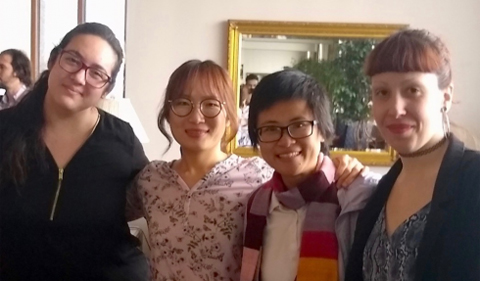Dr. Christine Moon Cho and three Linguistics graduate students—An Nguyen, Irene Lucena, and Carla Consolini—presented a research project at the Kentucky Foreign Language Conference, held at the University of Kentucky in Lexington on April 13.
They developed the project through LING 5940, the Linguistics Research Experience course, which encourages students to explore interesting research topics in the field of linguistics while gaining hands-on research experience. A wide range of activities were used both inside and outside of the classroom, such as recruiting participants and learning how to use the Praat software for acoustical analysis. While taking the course, the team members were infused with a shared passion for the musical aspects of language and intonation, and their role in second language acquisition.
The team investigated whether the intonation patterns in a person’s first language have influence on the acquisition of a second language. In particular, they were interested in Korean English as a Foreign Language (EFL) learners’ production of English intonation due to significant differences between the systems of intonation of the two languages. A difference of note is that English marks the prominence of a word by pitch accent while in Korean, the prominence is associated with the location of a word. The team therefore hypothesized that Korean EFL speakers may experience challenges when using English intonation, particularly when expressing intentions, which generally requires a greater use of intonation than neutral utterances. When communicating with native English speakers, for example, Korean speakers of English may seem ‘emotionless’ or ‘insincere’ due to their own neutral and monotonous intonation. At times, they also may misinterpret the emotional cues conveyed in their interlocutor’s intonations.
The research and subsequent presentation was a collaborative effort. The team analyzed the phonological (intonation contour) and non-phonological (pitch, intensity, and duration) features of Korean EFL learners’ speech samples at the syllable and utterance levels. They compared the speech sample data of both Korean and North American undergraduate students. They analyzed the overall ‘up-and-down’ patterns of English intonation—pitch-related parameters such as the minimum and maximum of pitch, which refer to the lowest and highest pitch levels. They also measured the duration of each utterance and the intensity, meaning how strong the speaker sounds, by using the Praat acoustic software.
The results of the study highlighted the L1 transfer effect, which refers to phenomenon observed among learners of other languages applying knowledge from one language to another language. Korean participants used a different ‘pausing’ pattern and utilized a narrower range of pitch variations, which can contribute to diminishing the pragmatic force of their spoken messages by sounding more neutral than they intended.
The study was well received and the team felt that they have contributed to increasing the visibility of the pragmatic issues that are not given enough attention in the area of second language learning. Dr. Cho and the students are grateful, as An Nguyen said, “for the perfect combination of hard work and play experienced” while visiting Lexington.




















Comments